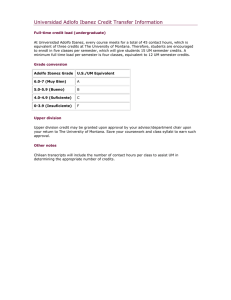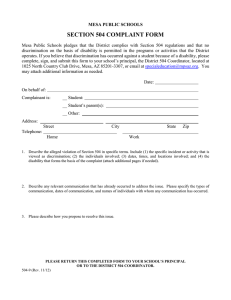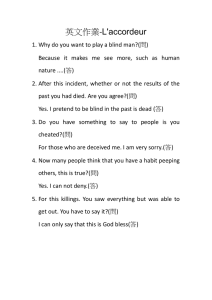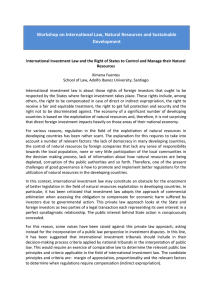JJ Rico, AZ State Bar #021292 Cathleen Dooley, AZ State Bar
advertisement
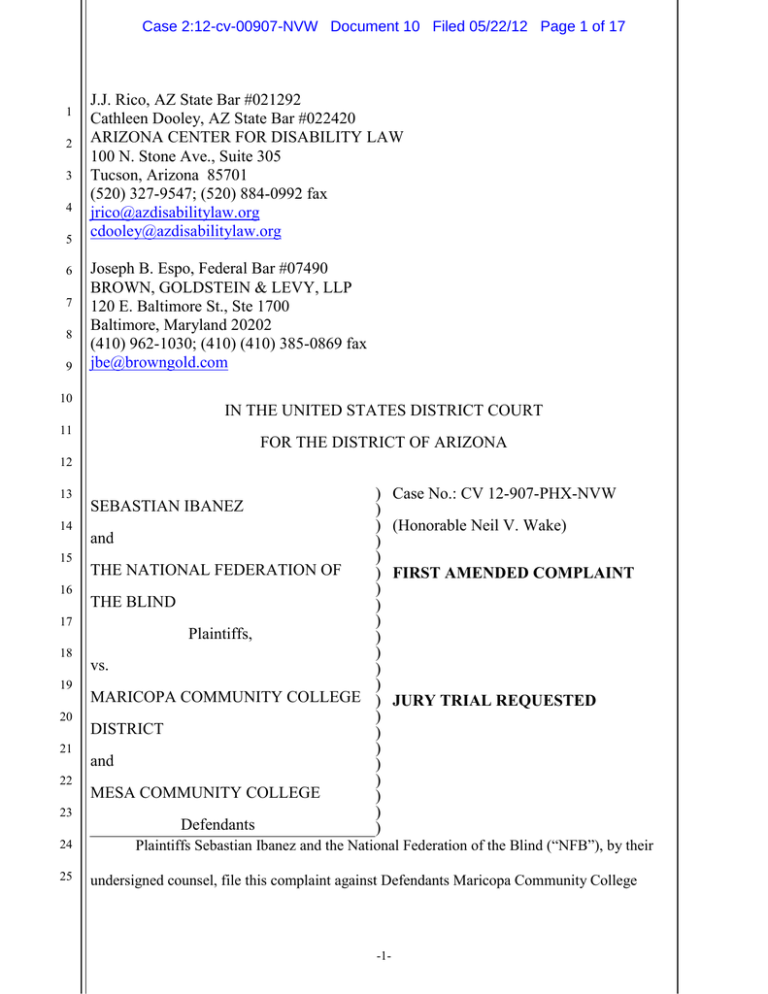
Case 2:12-cv-00907-NVW Document 10 Filed 05/22/12 Page 1 of 17 1 2 3 4 5 6 7 8 9 10 J.J. Rico, AZ State Bar #021292 Cathleen Dooley, AZ State Bar #022420 ARIZONA CENTER FOR DISABILITY LAW 100 N. Stone Ave., Suite 305 Tucson, Arizona 85701 (520) 327-9547; (520) 884-0992 fax jrico@azdisabilitylaw.org cdooley@azdisabilitylaw.org Joseph B. Espo, Federal Bar #07490 BROWN, GOLDSTEIN & LEVY, LLP 120 E. Baltimore St., Ste 1700 Baltimore, Maryland 20202 (410) 962-1030; (410) (410) 385-0869 fax jbe@browngold.com IN THE UNITED STATES DISTRICT COURT 11 FOR THE DISTRICT OF ARIZONA 12 13 14 15 16 17 18 19 20 21 22 23 24 25 ) ) ) and ) ) THE NATIONAL FEDERATION OF ) ) THE BLIND ) ) Plaintiffs, ) ) vs. ) ) MARICOPA COMMUNITY COLLEGE ) ) DISTRICT ) ) and ) ) MESA COMMUNITY COLLEGE ) ) Defendants ) SEBASTIAN IBANEZ Case No.: CV 12-907-PHX-NVW (Honorable Neil V. Wake) FIRST AMENDED COMPLAINT JURY TRIAL REQUESTED Plaintiffs Sebastian Ibanez and the National Federation of the Blind (“NFB”), by their undersigned counsel, file this complaint against Defendants Maricopa Community College -1- Case 2:12-cv-00907-NVW Document 10 Filed 05/22/12 Page 2 of 17 District and Mesa Community College for violating federal anti-discrimination laws that require 1 2 public entities to provide equal opportunity to people with disabilities. They allege as follows: I. INTRODUCTION 3 1. 4 In 2009 Mr. Ibanez enrolled as a student at Mesa Community College (“Mesa”), 5 one of 10 campuses that make up the Maricopa Community College District (“Maricopa” or the 6 “District”). He is a candidate for an associate’s degree. Mr. Ibanez is blind. Throughout his 7 enrollment at Mesa Mr. Ibanez has been subjected to discriminatory treatment in the way he 8 must register for classes, prepare for classes, submit homework for classes and in other aspects 9 10 of student life. The discrimination culminated in January 2011 when Mr. Ibanez was excluded from a class for the sole reason that he is blind. 11 2. The NFB learned of Mesa’s discriminatory treatment of blind students in 12 February 2012. As an organization dedicated to achieving integration and equal rights for blind 13 14 15 individuals, the NFB has had to expend its limited resources to counteract Mesa’s discrimination and, therefore, has been harmed by Mesa and Maricopa. II. JURISDICTION 16 3. 17 This court has subject matter jurisdiction pursuant to 28 U.S.C. § 1331 for 18 Plaintiff's claims arising under the Americans with Disabilities Act (“ADA”), 42 U.S.C. 19 §§ 12131, et seq. and Section 504 of the Rehabilitation Act of 1973 (“Section 504”), 29 U.S.C. 20 § 794. 21 22 III. PARTIES 4. Sebastian Ibanez immigrated to the United States as a teenager and graduated 23 from high school in 2002. He has been blind since birth and partly deaf since a childhood case of 24 the mumps. Mr. Ibanez’s primary means of reading is by use of screen reader software named 25 -2- Case 2:12-cv-00907-NVW Document 10 Filed 05/22/12 Page 3 of 17 Jobs Access for Windows (“JAWS”). JAWS is a program that converts text that is displayed 1 2 visually on a computer monitor into synthesized speech. JAWS can read whatever is on a 3 computer screen as long as the digital material is properly coded. A proficient JAWS user can 4 read in much the same way as a sighted reader, using keystrokes to move through text, change 5 the speed at which he is reading and navigate back and forth through text or skipping irrelevant 6 text. 7 8 9 10 5. Mr. Ibanez received training in JAWS and braille at his high school as well as at the Arizona Center for the Blind after high school. 6. In high school Mr. Ibanez read with braille and with JAWS, which are his primary methods for reading. Readers were used only for work that could not be converted to digital 11 format in a timely fashion. 12 7. Mr. Ibanez has been a successful student. While attending Mesa full-time he also 13 14 15 16 has worked as a motivational speaker and has mentored children on a volunteer basis. Mr. Ibanez is married and has one child. 8. The NFB is a non-profit corporation duly organized under the laws of the District 17 of Columbia with its principal place of business in Baltimore, Maryland. With more than 50,000 18 members, the NFB is the largest and most influential membership organization of blind people in 19 the United States. The NFB has affiliates in all fifty states, in the District of Columbia, and in 20 Puerto Rico, and over seven hundred local chapters in most major cities. The NFB has a state 21 22 affiliate in Arizona and local chapters in Tucson, Phoenix, the East and West Valleys, and Yuma. Defendant Maricopa Community College District is a public educational district supported with 23 property tax revenue, state aid, tuition payments and federal financial assistance. 24 25 -3- Case 2:12-cv-00907-NVW Document 10 Filed 05/22/12 Page 4 of 17 9. Defendant Mesa Community College is one of the 10 constituent schools of the 1 2 3 4 5 Maricopa Community College District. Like the District, Mesa is supported through property tax revenue, state aid, tuition and federal financial assistance. 10. Both defendants are recipients of federal financial assistance as that term is used in the Rehabilitation Act and, therefore, must comply with Section 504. 6 7 IV. FACTS 11. Because he is blind Mr. Ibanez has been denied the same educational 8 opportunities as sighted students throughout his time as a Mesa student. That discrimination has 9 existed at every step of Mr. Ibanez’s matriculation as set out in the facts below. 10 12. Because the Maricopa and Mesa web sites are needlessly inaccessible to blind 11 users Mr. Ibanez, unlike his sighted classmates, is and at all times has been unable to register for 12 his own classes or use his student e-mail account through which important information is 13 14 15 communicated. Because of that Mr. Ibanez has found himself enrolled in classes with too few credits to maintain his full-time student status, jeopardizing financial assistance he gets for 16 attending college, or, conversely, enrolled in more credits than he intended, being charged extra 17 for those additional credits. 18 13. Because the Mesa financial aid office requires students to “sign in” via an 19 inaccessible computer interface in the office’s waiting room, and office staff refuse to talk to 20 anyone who has failed to sign in – even if that person seeks assistance in order to sign in – Mr. 21 22 Ibanez has been unable to meet with financial aid counselors except when he successfully begged other students in the waiting room to fill out the computer form on his behalf. 23 24 25 -4- Case 2:12-cv-00907-NVW Document 10 Filed 05/22/12 Page 5 of 17 14. Because of various inaccessible computer sites utilized by Mesa faculty 1 2 3 4 Mr. Ibanez has been unable to access class readings that his sighted classmates can read on programs called Blackboard or Web CT. 15. Because professors at Mesa often give examinations only in written formats 5 Mr. Ibanez must have a reader with him when he takes most of his school exams, even though 6 his primary method of reading is with a computer program called JAWS, which converts 7 computer text to synthesized speech. 8 9 10 16. Mr. Ibanez also has been denied the same educational opportunities as his sighted classmates because he has been unable to access a program called MyMathLab and another program used in his Spanish class. 11 17. Mr. Ibanez took a computer class at Mesa known as CIS 105, which is described 12 as providing an overview of computer technology, concepts and terminology. Although the 13 14 15 course is described as teaching the use of word processing, spreadsheet, database, and presentation software, all of the instruction was targeted toward sighted students who were able 16 to use a mouse. The instructor did not provide any instruction in the use of keyboard commands 17 to perform functions. 18 18. Mr. Ibanez has taken numerous communications classes that required the use of 19 Blackboard, an online course management software program. Mr. Ibanez found that he could 20 read assigned material on the Blackboard web page only if a sighted person navigated to the 21 22 reading, and then could not answer the questions that were asked after the reading or submit those answers to the teacher. Instead, he had to use a reader for that function, limiting his choice 23 of when to do the work. This is a problem that continues to this day, when Mr. Ibanez is taking 24 another class requiring the use of Blackboard. 25 -5- Case 2:12-cv-00907-NVW Document 10 Filed 05/22/12 Page 6 of 17 19. Similarly, Mr. Ibanez was unable to access a computer program known as 1 2 3 4 5 6 MyMathLab when he was enrolled in two math classes. Instead, Mr. Ibanez used a book with a reader. 20. Mr. Ibanez also was unable to use a web-based program for a Spanish class he took. Instead, he had to work with a reader. 21. Mr. Ibanez has taken classes in which his professors have used inaccessible 7 “clickers,” a type of automated response device. The professor would put up a study guide on a 8 board and students were supposed to click the letter for what they thought was the correct 9 answer. The instructor would then tell students which answer was correct. Because the “clickers” 10 were not marked in a way that enabled Mr. Ibanez to distinguish the letters, he was unable to use 11 them without assistance. 12 22. Over the course of his enrollment at Mesa, Mr. Ibanez has attended many classes 13 14 15 16 17 in which videos without audio description were displayed. On those occasions, his note-taker would have to try to tell Mr. Ibanez what was appearing in the video. They were used in history, psychology, communications and other classes. 23. Mesa and Maricopa use a variety of Google applications as part of their student 18 software package. These tools, too, are inaccessible because they may only be reached through 19 the inaccessible MyMaricopa and MyMesa internet portals. Additionally, Google Calendar is 20 completely inaccessible because none of its calendar details have been properly coded for 21 22 compatibility with JAWS. 24. In order to get accessible textbooks Mr. Ibanez would have to purchase required 23 books and bring them to the Disability Resources and Services Office six weeks in advance, 24 where they would be scanned into an accessible format. Because syllabi and book lists were 25 -6- Case 2:12-cv-00907-NVW Document 10 Filed 05/22/12 Page 7 of 17 often not available so long before the start of classes, Mr. Ibanez was often forced to begin 1 2 classes without required readings. 25. 3 At times, Mr. Ibanez, like many of his classmates, would drop one class and 4 enroll in another. In those cases, the DRS office was unable to prepare materials and Mr. Ibanez 5 relied on a reader for the class for the whole semester. 6 26. On Monday, January 24, 2011, the last day of that semester’s “add/drop” period, 7 Mr. Ibanez went to the DRS office to add a counseling class to his schedule. Because the web- 8 based student registration system is inaccessible to people who are blind, Mr. Ibanez needed the 9 10 assistance of someone to add the class. With the assistance of Chris Saiz at DRS Mr. Ibanez added a class with the title of CPD 102, taught by Lois Bartholomew. Either because he did not 11 notice or did not recognize its significance, Mr. Saiz failed to tell Mr. Ibanez that he had signed 12 up for a two credit class instead of the three credit class he needed to maintain his full-time 13 14 15 status. 27. On Tuesday, January 25, Mr. Ibanez went to his counseling class for the first 16 time. When he approached Ms. Bartholomew she told him to have a seat and said they could talk 17 after class. 18 28. After class Ms. Bartholomew announced that she had a meeting after class. She 19 spoke individually with Mr. Ibanez and told him that she would call before the next class to 20 discuss accommodating his needs. 21 22 29. On Thursday, January 27, not having heard from Ms. Bartholomew, Mr. Ibanez went to his next-scheduled class. He had, by that time, selected a student note-taker who was 23 with him. Before class began Ms. Bartholomew told Mr. Ibanez that she was a new teacher and 24 had not been informed that a blind student would be in her class. She suggested that Mr. Ibanez 25 -7- Case 2:12-cv-00907-NVW Document 10 Filed 05/22/12 Page 8 of 17 switch to a different section of the class, which was taught by a more experienced teacher. 1 2 3 4 Mr. Ibanez said that he would be privileged to work with Ms. Bartholomew to assist her on how to work with people with disabilities, an offer Ms. Bartholomew rejected. 30. Faced with Ms. Bartholomew’s rejection, Mr. Ibanez asked if the other class was 5 at the same time as hers, because the rest of his class schedule was set and could not be adjusted. 6 Ms. Bartholomew replied that her supervisor, Dr. Karen Hardin, was coming to speak with him. 7 31. When Dr. Hardin arrived she and Ms. Bartholomew had a conversation from 8 which Mr. Ibanez was excluded. Dr. Hardin then explained to Mr. Ibanez that her class was the 9 “same” as Ms. Bartholomew’s, except that it was an independent study class in which students 10 would meet with her once a week but otherwise perform their work independently on a computer 11 system called Web CT. Web CT is not accessible to the blind. 12 32. Mr. Ibanez told Dr. Hardin that he does not work well independently and did not 13 14 15 16 agree to the switch into her class. As they walked to her office Dr. Hardin said she would call and schedule a meeting with Mr. Ibanez’s adviser at DRS. 33. On Friday, January 28, Mr. Ibanez spoke with several of his former teachers to 17 ask for letters explaining that he had done well in their classes. One of those teachers looked at 18 Mr. Ibanez’s information on the MyMaricopa web site portal and discovered that he had been 19 dropped from Ms. Bartholomew’s CPD 102 class as a no show. That was done without Mr. 20 Ibanez’s knowledge or consent. 21 22 34. The following Monday, Mr. Ibanez met with Mr. Saiz and Winifred “Wink” Harner, the then-manager of DRS to discuss the events that had taken place. Mr. Ibanez stressed 23 the importance of resolving the issue before class the next day. Ms. Harner said she would speak 24 with the teachers involved in an effort to resolve the issue. 25 -8- Case 2:12-cv-00907-NVW Document 10 Filed 05/22/12 Page 9 of 17 35. On the evening of Monday, January 31, Ms. Harner called Mr. Ibanez and told 1 2 him that he should come by the DRS office the following day to pick up an Add/Drop form for 3 Ms. Bartholomew’s class. Mr. Ibanez did so, and also picked up an Instructor Notification Form 4 (“INF”) that is used by Mesa to inform faculty of accommodations for students. Mr. Ibanez then 5 went to the class with his note-taker. 6 36. When Mr. Ibanez went to the class, Ms. Bartholomew would not take the INF 7 from him and said that he should go meet with her supervisor again. At noon on February 1 8 Mr. Ibanez met with Dr. Hardin, who told him that Ms. Bartholomew would get in touch about 9 10 coming back to class. By that time, Mr. Ibanez had missed five classes. Not until 8:00 p.m. on Thursday, February 3 – after the sixth class had already taken place – did Mr. Ibanez receive an 11 e-mail from Ms. Bartholomew telling him he could attend class. By that time, Mr. Ibanez did not 12 think he could catch up on the work he had missed and declined to enroll. 13 14 15 16 17 18 37. Mr. Ibanez has suffered severe emotional distress due to the intentional discriminatory acts of the District, Mesa and their employees. 38. Defendants’ actions have caused and continue to cause distinct, palpable, and perceptible injury to the NFB. 39. The NFB’s mission is to promote the general welfare of blind people by (1) 19 assisting blind people in their efforts to integrate themselves into society on terms of equality and 20 independence; and (2) removing barriers and changing social attitudes, stereotypes and mistaken 21 22 beliefs sighted and blind people hold concerning the limitations created by blindness that result in the denial of opportunity to blind people in virtually every sphere of life. 23 40. The NFB improves the lives of blind people through advocacy, education, 24 research, technology, and programs encouraging independence and self-confidence. By 25 -9- Case 2:12-cv-00907-NVW Document 10 Filed 05/22/12 Page 10 of 17 providing public education about blindness, information and referral services, scholarships, 1 2 literature and publications about blindness, aids and appliances and other adaptive equipment for 3 the blind, advocacy services and protection of civil rights, development and evaluation of 4 technology, and support for blind persons and their families, members of the NFB strive to 5 educate the public that the blind are normal individuals who can compete on terms of equality. 6 41. The NFB’s mission includes working to ensure that blind college students have an 7 equal opportunity to benefit from the education they receive, and to participate in and benefit 8 from the programs and activities of their schools without discrimination on the basis of 9 10 disability. 42. The NFB furthers this mission in many ways, including giving blind high school 11 and college students leadership training and scholarships and founding three national centers for 12 acquiring blindness skills. It also does so by advocating for state and federal legislation to help 13 14 15 16 17 18 blind college students obtain equal access to textbooks and by working with state legislatures to enact laws requiring equal access to electronic material. 43. Defendants’ discrimination has frustrated the NFB’s mission and caused it to divert resources to identify and counteract Defendants’ discriminatory practices. 44. Defendants’ discrimination has been and continues to be a barrier to the full 19 participation of blind students and therefore, frustrates the NFB’s mission to achieve full 20 inclusion for blind people. Among other things, the NFB’s mission is frustrated by Defendants’ 21 discrimination because it impedes blind students’ ability to compete on an equal basis. 22 45. Defendants’ discrimination has required and continues to require the NFB to 23 make a greater effort—and to allocate resources—to educate the public that such discrimination 24 25 -10- Case 2:12-cv-00907-NVW Document 10 Filed 05/22/12 Page 11 of 17 is wrong and otherwise to counteract the adverse impact of such discrimination. This perceptibly 1 2 3 impairs the NFB’s counseling, advocacy, educational, and training missions. 46. Defendants’ discrimination sends the message that it is acceptable for a college to 4 adopt inaccessible technology and other services, programs, or activities that exclude and 5 discriminate against blind students. This frustrates the NFB’s mission and makes it more 6 difficult for the NFB to convince schools and other entities with services, programs, or activities 7 involving emerging technology that those services, programs, and activities may not 8 discriminate. 9 10 47. The NFB has also devoted and continues to devote resources to identify and counteract Defendants’ discrimination and its effects in the community. 11 48. These actions that the NFB has taken to identify and counteract Defendants’ 12 discrimination have diverted resources from other important programs. For example, NFB staff 13 14 15 members must continue to conduct outreach and counseling to blind students given widespread discrimination in institutions of higher education such as Mesa. The NFB also has had to 16 continue to expend resources on working to make higher education, and the emerging technology 17 used in the education field, accessible to blind individuals. 18 49. All of the activities undertaken to identify and counteract the effects of 19 Defendants’ discrimination have caused economic losses to the NFB in the form of staff pay, 20 attorney and consultant fees, and/or other funds spent on those activities. 21 22 50. The NFB’s injuries—including, without limitation, those described herein—are traceable to the Defendants’ discriminatory conduct alleged in this Complaint and will be 23 redressed by the relief requested in it. 24 25 -11- Case 2:12-cv-00907-NVW Document 10 Filed 05/22/12 Page 12 of 17 CAUSES OF ACTION 1 2 COUNT I Violations of title II of the Americans with Disability Act 42 U.S.C. § 12131 et seq. 3 4 51. Plaintiffs incorporate the allegations in paragraphs 1 through 50 as if restated. 52. The ADA, 42 U.S.C. § 12132 et seq. guarantees equal access for qualified 5 6 individuals to the benefits of the services, programs or activities of a public entity. 7 53. Title II of the ADA mandates, inter alia, that “no qualified individual with a 8 9 10 11 12 13 14 15 16 17 disability shall, by reason of such disability, be excluded from participation in or be denied the benefits of the services, programs, or activities of a public entity, or be subjected to discrimination by any such entity.” 54. The Maricopa Community College District and Mesa Community College, funded with tax money, are public entities under title II of the ADA. 55. Classes and facilities at the District and Mesa are services, programs or activities provided by the Defendants. 56. Mr. Ibanez’s blindness substantially limits his major life activities. Therefore, Mr. Ibanez is an individual with a disability under the ADA. 18 57. Mr. Ibanez was admitted to the District and Mesa based on all general 19 requirements to be a student there and thus is a qualified individual entitled to the protection of 20 21 22 the ADA. 58. Defendants have failed to meet their obligations to provide blind students with 23 educational opportunities that are equal to those provided to students without disabilities. 24 Defendants have excluded Mr. Ibanez from participation in, denied him the benefits of, or 25 otherwise discriminated against him in the provision of their facilities, services and programs. -12- Case 2:12-cv-00907-NVW Document 10 Filed 05/22/12 Page 13 of 17 59. Defendants’ actions constitute intentional discrimination on the basis of a 1 2 disability in violation of the ADA, in that they: (1) have failed to maintain policies and 3 procedures to ensure compliance with title II, specifically policies that provide equal access and 4 effective communications to individuals with disabilities; (2) have failed to ensure that 5 communications with Mr. Ibanez was as effective as communications with non-disabled peers; 6 (3) have failed to provide auxiliary aids and services or to modify policies and procedures to 7 prevent discrimination; (4) have purchased and deployed new equipment that is inaccessible to 8 Mr. Ibanez after the effective date of the ADA; (5) have failed to provide education opportunities 9 10 and educational information in a manner that is timely, equally effective and equally integrated; (6) have excluded Mr. Ibanez from a class solely because he is blind; and (7) have otherwise 11 discriminated against Mr. Ibanez. 12 60. As a result of Defendants’ actions Mr. Ibanez has suffered actual damages, non- 13 14 15 16 economic damages, emotional distress, embarrassment and humiliation. The NFB has suffered actual damages because of Defendants’ action due to its diversion of resources. 61. So long as Defendants continue to discriminate against blind students, the NFB 17 will continue to suffer harm through frustration of its mission and diversion of resources required 18 to counteract the discrimination. 19 20 21 62. Defendants’ actions were done intentionally or with deliberate indifference to Mr. Ibanez’s protected rights. As such, Plaintiffs are entitled to monetary damages pursuant to 42 U.S.C. § 12133 for each and every offense. 22 COUNT II Violation of § 504 of the Rehabilitation Act of 1973, 29 U.S.C. § 794 et seq. 23 24 25 63. Plaintiffs incorporate by references paragraphs 1 through 62 as if restated. -13- Case 2:12-cv-00907-NVW Document 10 Filed 05/22/12 Page 14 of 17 64. Section 504 of the Rehabilitation Act mandates that “[n]o otherwise qualified 1 2 individual with a disability . . . shall, solely by reason of her or his disability, be excluded from 3 the participation in, denied the benefits of, or be subjected to discrimination under any program 4 or activity receiving Federal Financial assistance.” 5 65. Section 504 defines “program or activity,” in pertinent part, as “all of the 6 operations of a department, agency, special purpose district, or other instrumentality of a State or 7 local government; or the entity of such State or local government that distributes such assistance 8 and each such department or agency (and each other State or local government entity) to which 9 the assistance is extended, in the case of assistance to a State or local government …” 29 U.S.C. 10 § 794(b)(1). 11 66. Defendants receive grants, contracts and other federal financial assistance that 12 make them subject to the requirements of Section 504. 13 14 15 67. Mr. Ibanez is blind and was admitted to the District and Mesa based on all general requirements to be a student there and thus is a qualified individual with a disability 16 under Section 504. 17 68. Defendants have, solely by reason of Mr. Ibanez’s disability, excluded him from 18 participation in, denied him the benefits of or otherwise discriminated against him in its facilities, 19 services, programs or activities. Defendants’ violations of Section 504 and its regulations deny 20 Mr. Ibanez meaningful access to the public benefit of education at the Colleges. 21 22 69. Defendants’ actions constitute intentional discrimination on the basis of a disability in violation of Section 504, in that they: (1) have failed to maintain policies and 23 procedures to ensure compliance with Section 504, specifically policies that provide equal access 24 and effective communications to individuals with disabilities; (2) have failed to ensure that 25 -14- Case 2:12-cv-00907-NVW Document 10 Filed 05/22/12 Page 15 of 17 communications with Mr. Ibanez were as effective as communications with non-disabled peers; 1 2 (3) have failed to provide auxiliary aids and services or to modify policies and procedures to 3 prevent discrimination; (4) have purchased and deployed new equipment that is inaccessible to 4 Mr. Ibanez after the effective date of Section 504; (5) have failed to provide education 5 opportunities and educational information in a manner that is timely, equally effective and 6 equally integrated; (6) have excluded Mr. Ibanez from a class solely because he is blind; and (7) 7 have otherwise discriminated against Mr. Ibanez. 8 9 10 70. As a result of Defendants’ actions Mr. Ibanez has suffered actual damages, non- economic damages, emotional distress, embarrassment and humiliation. The NFB has suffered actual damages because of Defendants’ action due to its diversion of resources. 11 71. So long as Defendants continue to discriminate against blind students, the NFB 12 will continue to suffer harm through frustration of its mission and diversion of resources required 13 14 15 to counteract the discrimination. 72. Defendants actions were done intentionally or with deliberate indifference to Mr. 16 Ibanez’s protected rights. As such, Plaintiffs are entitled to monetary damages pursuant to 29 17 U.S.C. § 794(a). 18 PRAYER FOR RELIEF 19 WHEREFORE, Plaintiffs respectfully pray: 20 1. That this Court assume jurisdiction; 21 2. That this Court declare Defendants’ conduct, as described more fully above, to be in 22 violation of title II of the ADA and section 504 of the Rehabilitation Act; 23 3. That this Court issue an injunction ordering Defendants to comply with title II of the 24 ADA and section 504 of the Rehabilitation Act with respect to the inclusion of blind 25 -15- Case 2:12-cv-00907-NVW Document 10 Filed 05/22/12 Page 16 of 17 students in classes and the provision of accessible technology, programs, services, 1 2 3 4 and activities; 4. That this Court award Plaintiffs compensatory damages under title II of the ADA and section 504 of the Rehabilitation Act; 5 5. That this Court award Plaintiffs reasonable attorneys’ fees and costs; and 6 6. That this Court award such additional or alternative relief as may be just, proper, and 7 equitable 8 9 10 Respectfully submitted this 22nd day of May, 2012. ARIZONA CENTER FOR DISABILITY LAW 11 12 13 14 15 s/J.J. Rico J.J. Rico Cathleen M. Dooley Arizona Center for Disability Law 100 N. Stone Ave., Ste. 305 Tucson, Arizona 85701 16 17 BROWN, GOLDSTEIN & LEVY, LLP 18 19 20 21 22 s/Joseph B. Espo Joseph B. Espo Brown, Goldstein & Levy, LLP 120 E. Baltimore St., Ste. 1700 Baltimore, Maryland 20202 Attorneys for Plaintiffs 23 24 25 -16- Case 2:12-cv-00907-NVW Document 10 Filed 05/22/12 Page 17 of 17 CERTIFICATE OF FILING AND SERVICE 1 2 Pursuant to the Case Management/Electronic Case Filing Administrative Policies and Procedures Manual (“CM/ECF Manual”) of the United States District Court for the District of 3 Arizona, I hereby certify that on the 22nd day of May, 2012, my office electronically transmitted 4 the foregoing First Amended Complaint to the U.S. District Court clerk’s office for filing. 5 6 I hereby certify that on May 22, 2012, I served the foregoing document by U.S. Mail on the following, who are not registered participants of the CM/ECF System: 7 8 9 10 11 12 13 14 15 Joseph T. Clees Nonnie L. Shivers Ogletree Deakins 2415 East Camelback Rd., Ste 800 Phoenix, AZ 85016 Attorneys for Defendants Maricopa Community College District and Mesa Community College Pursuant to Section D(2) of the CM/ECF Manual, we have mailed a courtesy copy of the First Amended Complaint to the assigned Judge, the Honorable Neil V. Wake. s/c.goyette 16 17 18 19 20 21 22 23 24 25 -17-
